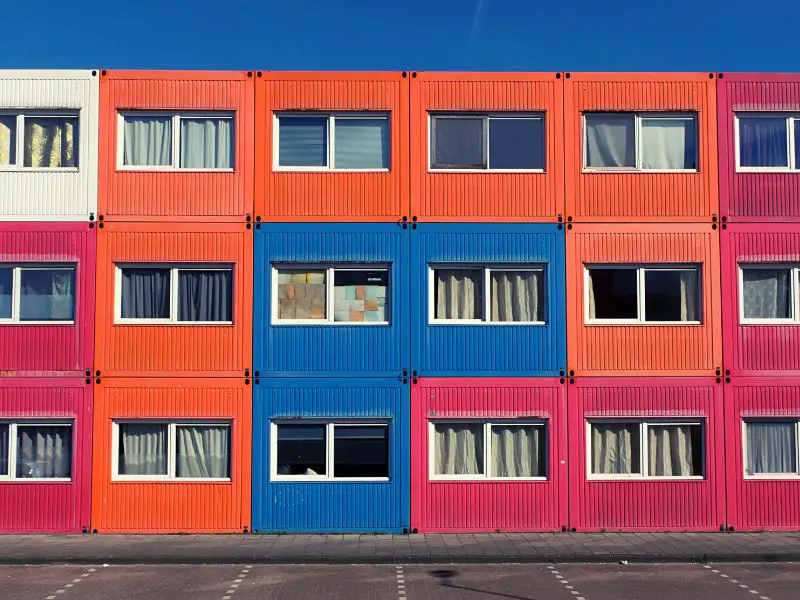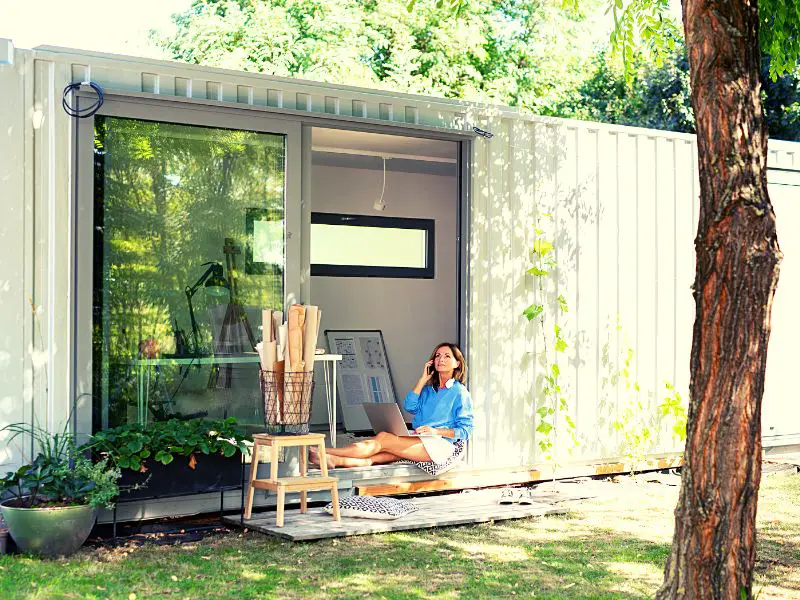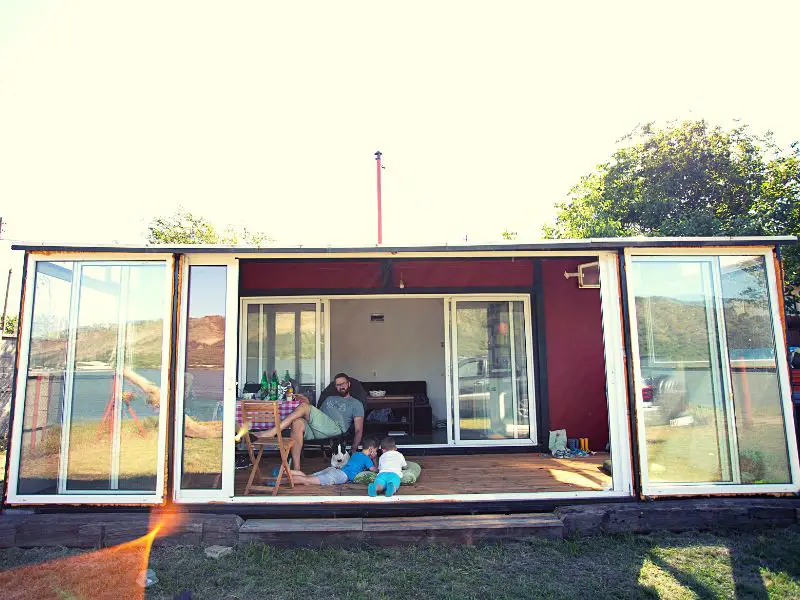Containers are rapidly gaining popularity. But they’re not just for storing items. They’re also being used for housing. And it’s easy to see why. Container houses are literally what they sound like: homes constructed from the steel shipping containers you see transporting commodities on trains, trucks, and ships. People are building houses of various shapes and sizes with these enormous Lego bricks.
Building container homes is one of the hottest trends in residential construction today. Roughly 20,000 container homes were built in 2016. Fast forwarding to today, the number only grows.

The History of Shipping Containers as Homes
The housing industry has been going in the wrong direction since the financial crisis of 2008. While buying a home is still considered part of the American Dream, more and more people either can’t afford to buy a house or aren’t even looking to do so.
As housing demand has been rising for the past few decades, there’s a new housing market trend emerging: container homes. Container homes could become a legitimate alternative for home ownership due to their affordability and ease of construction.
Since the end of World War II, shipping containers have become a staple of international commerce. They were first invented in 1956 by Malcolm McLean, who opened his first container ship in 1956. Since then, shipping containers have become one of the most efficient forms of transport, as they are incredibly cheap to build, extremely sturdy, and can be easily stacked and transported.
After their initial use, people began repurposing and living in shipping containers. At first, it was used for camping, as people could set up their containers in a parking lot, but modern shipping containers are much better suited for living. They come with electricity, air conditioning, and a kitchen and bathroom. You can even add solar panels to the roof, allowing you to generate your electricity. Shipping containers are not only efficient, but they are cheap.

Since their invention, they have revolutionized the way we move goods worldwide. Currently, there are about 17 million shipping containers in use around the world. That’s a lot of containers! And recently, people have started using them as homes. Shipping containers are cheap, strong, and eco-friendly. They’re also modular, so it’s easy to put them together. So, if you’re considering building a home, you might want to look at shipping container homes.
Advantages of Container Homes
1. Shipping Homes Are Quick to Build
A container home is nothing different from a regular house other than its materials. Containers are stacked on top of each other to make a house. They can be quickly built, which makes them an ideal housing solution for people looking for cheap housing options.
You also have a basic foundation. The walls, roof, and floor are already provided. This means you don’t have to pay for the framework of your home. If you have the skills to build it yourself, you can also reduce the construction cost.
2. Shipping Homes Have a Predictable Cost
Shipping homes have a predictable cost. They performed most of the work on the manufacturing floor for a set fee. The variable expenses are delivery to the site, site preparation, foundation, assembly, and utility connections. Moreover, container homes are not necessarily more affordable. Some estimates place the savings between 5 to 10 percent, depending on what is being compared.
3. Shipping Homes Can Stand the Test of Time
A shipping container is built to withstand extreme weather conditions at sea for thousands of miles on end without sustaining any damage. This is what makes it ideal for long-term use in a land-based setting.
The lifespan of a shipping container is longer than that of a brick or wood structure. This is because of the materials used in their construction: corrugated steel and plywood. Steel can withstand harsh weather conditions and last for decades without losing its structural integrity. Plywood can be re-coated multiple times in its lifetime to make it last even longer. Also, they’re easy to recycle when they finally need to be disposed of.
4. Shipping Homes Are Sustainable for the Environment
Container homes can be built very efficiently, as they are made from reused shipping containers. The construction process also takes less time than traditionally constructed homes, reducing pollution from building a house. These homes are also much easier to clean and maintain, making them more environmentally sustainable. But, these aren’t the only benefits. Container homes are more affordable, require less space than traditional homes, and can suit any family’s needs.

The thought that you are making a house out of a wasted byproduct of the shipping industry is one of the environmental selling edges of constructing houses using shipping containers. This can be beneficial in some aspects. However, it’s not always accurate or a good thing.
Container houses are sometimes touted as ecologically beneficial since they are constructed from repurposed shipping containers, preserving metal resources. There are plenty of unused shipping containers on the market, and the concept of converting them into residences is appealing. However, from a sustainability standpoint, is a house the best use for shipping containers? Several would disagree.
Disadvantages of Container Homes
1. Harmful Chemicals
Container homes can contain traces of gasoline and oil from when it was used as a cargo vessel. Lead paint used in the container’s original construction may also peel off. Formaldehyde and other harmful chemicals used in the manufacturing process of the container may leak out over time and cause health problems for your family, such as allergies and skin rashes.
You should also thoroughly research whether the shipping line that owned the container had any hazardous cargo shipped in it previously or not so that you are not exposed to these dangerous chemicals. With proper provisions, you can minimize the risk of exposure to harmful chemicals by building a shipping container home for yourself!
2. Permits and Codes
Concerns with using a used shipping container as a residence include obtaining permits for using it as your residence. Some cities may also have building codes that need to be followed for building a home out of a container. This may include the addition of stairs to the unit so that the fire department can get in if needed in case of an emergency, as well as plumbing codes for connecting it to the city sewer and water lines. Some communities may have additional requirements that need to be met before you can even begin building out of a container, such as a zoning permit for the property where you intend to develop the unit.
While it may not be challenging to acquire a zoning permit in most areas, obtaining a license for using a used shipping container as a residence can be more challenging in some communities because of the additional regulations required due to the nature of the containers. Check with the local government about permits before you begin your project so you can avoid delays or other complications later on.
3. High Internal Temperature
Because they’re made of metal, the walls are very good at conducting heat in hot climates. So if you reside in a hot environment, you may face a high internal temperature level during the summer due to heat transfer from the walls.
A solution to this problem would be to use an air conditioner to cool down your home during the summer months. On the other hand, if you’re residing in a cold climate, you may experience the opposite problem: your home becomes too cold during winter.
Is a Container Home a Good Investment or Asset?
Container homes have a good resale value of at least 100 percent, and the ability to load them on a truck and transport them anywhere makes them highly desirable. This makes them an excellent asset to have if you’re thinking of moving somewhere new or if you want to rent out your container home to others to help offset the cost of purchasing it in the first place.
If you decide to sell your container home later on down the road, you’ll likely have no problems finding a buyer for it at a reasonable price! They’re easy to build, versatile, and affordable!

Investing in shipping container houses is more profitable than investing in equities, assuming all is done correctly. It’s like investing in a typical residential home, which might boost your cash flow significantly and meet your present and future demands.
While building a shipping container home is a viable option if you’re on a tight budget and need to build a house as quickly as possible, you will need to put in the effort to meet all the requirements and regulations required to get approval to build a container house in your area. If you manage to sort out all the obstacles, you’ll definitely have a solid investment for the future!


2 thoughts on “An Overview of Container Homes: Their Advantages and Disadvantages”